
Francis Scott Key was an American lawyer, author, and amateur poet from Frederick, Maryland, best known as the author of the text of the U.S. national anthem, "The Star-Spangled Banner". Key observed the British bombardment of Fort McHenry in 1814 during the War of 1812. He was inspired upon seeing the American flag still flying over the fort at dawn and wrote the poem "Defence of Fort M'Henry"; it was published within a week with the suggested tune of the popular song "To Anacreon in Heaven". The song with Key's lyrics became known as "The Star-Spangled Banner" and slowly gained in popularity as an unofficial anthem, finally achieving official status more than a century later under President Herbert Hoover as the national anthem.

"The Star-Spangled Banner" is the national anthem of the United States. The lyrics come from the "Defence of Fort M'Henry", a poem written on September 14, 1814, by 35-year-old lawyer and amateur poet Francis Scott Key after witnessing the bombardment of Fort McHenry by British ships of the Royal Navy in Outer Baltimore Harbor in the Patapsco River during the Battle of Baltimore in the War of 1812. Key was inspired by the large U.S. flag, with 15 stars and 15 stripes, known as the Star-Spangled Banner, flying triumphantly above the fort during the U.S. victory.

Fort McHenry is a historical American coastal pentagonal bastion fort on Locust Point, now a neighborhood of Baltimore, Maryland. It is best known for its role in the War of 1812, when it successfully defended Baltimore Harbor from an attack by the British navy from the Chesapeake Bay on September 13–14, 1814.

Marius Jean Antonin Mercié, was a French sculptor, medallist and painter.

The Battle of Baltimore was a sea/land battle fought between British and American forces in the War of 1812. American forces repulsed sea and land invasions off the busy port city of Baltimore, Maryland, and killed the commander of the invading British forces. The British and Americans first met at the Battle of North Point. Though the Americans retreated, the battle was a successful delaying action that inflicted heavy casualties on the British, halted their advance, and consequently allowed the defenders at Baltimore to prepare for an attack properly.
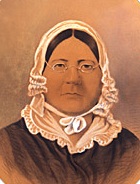
Mary Pickersgill was the maker, along with thirteen-year-old Grace Wisher, her African American enslaved servant, of the Star-Spangled Banner hoisted over Fort McHenry during the Battle of Baltimore in the War of 1812. The daughter of another noted flag maker, Rebecca Young, Pickersgill learned her craft from her mother, and, in 1813, was commissioned by Major George Armistead to make a flag for Baltimore's Fort McHenry that was so large that the British would have no difficulty seeing it from a great distance. The flag was installed in August 1813, and, a year later, during the Battle of Baltimore, Francis Scott Key could see the flag while negotiating a prisoner exchange aboard a British vessel, and was inspired to pen the words that became the United States National Anthem in 1931.

The Francis Scott Key Bridge, also known originally as the Outer Harbor Crossing or simply as the Key Bridge or Beltway Bridge, is a steel arch-shaped continuous through truss bridge spanning the lower Patapsco River and outer Baltimore Harbor / Port in Baltimore, Maryland, United States. The main span of 1,200 feet (366 m) is the third longest span of any continuous truss in the world. It is also the longest bridge in the Baltimore metropolitan area.

Charles Henry Niehaus was an American sculptor.
Defenders Day is a longtime legal holiday on September 12, in the U.S. state of Maryland, in the City of Baltimore and surrounding Baltimore County. It commemorates the successful defense of the city of Baltimore on September 12-13-14, 1814 from an invading British force during the War of 1812, an event which led to the writing of the words of a poem, which when set to music a few days later, became known as "The Star-Spangled Banner", which in 1931 was designated as the national anthem of the United States.
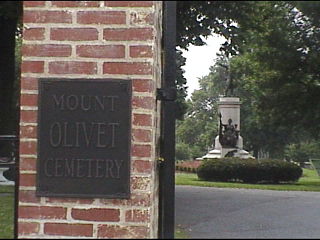
Mount Olivet Cemetery is a cemetery in Frederick, Maryland. The cemetery is located at 515 South Market Street and is operated by the Mount Olivet Cemetery Company, Inc.

The Star-Spangled Banner, or the Great Garrison Flag, was the garrison flag that flew over Fort McHenry in Baltimore Harbor during the naval portion of the Battle of Baltimore during the War of 1812. It is on exhibit at the National Museum of American History, Smithsonian Institution. Seeing the flag flying over Fort McHenry on the morning of September 14, 1814, after the battle ended, Francis Scott Key was inspired to write the poem "Defence of Fort M'Henry". These words were written by Key and set to the tune of "To Anacreon in Heaven", a popular song at the time, by John Stafford Smith. In 1931 the song became the national anthem of the United States.
The Holliday Street Theater also known as the New Theatre, New Holliday, Old Holliday, The Baltimore Theatre, and Old Drury, was a historical theatrical venue in Federal Period Baltimore, Maryland. It is known for showing the first performance of Francis Scott Key's "The Star-Spangled Banner".
Rebecca (Flower) Young was a flag maker during the American Revolution. Her name appears in the logs of the commissary general for making "Continental Standards" as early as 1781, making her one of the earlier verified makers of the Flag of the United States. In addition to flags, she was also paid for making blankets and drum cases between the years of 1780 and 1785. In 1781, Young ran an ad in the Pennsylvania Packet advertising "all kinds of colors for the Army and Navy." She also sewed the standard for the First American Regiment under Colonel Josiah Harmar.

War Memorial Plaza is a public square, small park and space in Downtown Baltimore between City Hall and the War Memorial Building, between Holliday Street on the west, East Fayette Street on the south, North Gay Street on the east, and East Lexington Street on the north.
Frank Key Howard was the grandson of Francis Scott Key and Revolutionary War colonel John Eager Howard. Howard was the editor of the Daily Exchange, a Baltimore newspaper sympathetic to the Confederacy. Just after midnight on September 13, 1861, he was arrested without a warrant at his home by U.S. Major General Nathaniel Prentice Banks on the direct orders of General George B. McClellan enforcing the policy of President Abraham Lincoln. The basis for his arrest was the writing of an editorial printed in his newspaper that was critical of Lincoln's suspension of the writ of habeas corpus, of the declaration by the Lincoln administration of martial law in Baltimore, and of the imprisonment without charge of Baltimore mayor George William Brown, sitting U.S. Congressman Henry May, all the police commissioners of Baltimore, and the entire city council. Lincoln's suspension of habeas corpus in Maryland had already been declared unconstitutional by U.S. Supreme Court Chief Justice Roger Taney in Ex parte Merryman, but Lincoln had ignored the federal court ruling. Howard was initially confined to Fort McHenry, the same fort his grandfather Francis Scott Key saw withstand a British bombardment during the War of 1812, which inspired him to write "The Star-Spangled Banner", which would become the national anthem of the United States of America. He was then transferred first to Fort Lafayette in Lower New York Bay off the coast of Brooklyn, then Fort Warren in Boston.

The Dupont Circle Fountain, formally known as the Rear Admiral Samuel Francis Dupont Memorial Fountain, is a fountain located in the center of Dupont Circle in Washington, D.C. It honors Rear Admiral Samuel Francis Du Pont, a prominent American naval officer and member of the Du Pont family. The fountain replaced a statue of Du Pont that was installed in 1884. Designed by Henry Bacon and sculpted by Daniel Chester French, the fountain was dedicated in 1921. Prominent guests at the dedication ceremony included First Lady Florence Harding, Secretary of War John W. Weeks and Secretary of the Navy Edwin Denby.
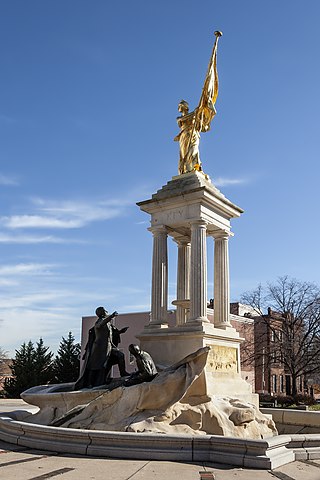
The Francis Scott Key Monument is an outdoor sculpture to Francis Scott Key in Baltimore, Maryland.
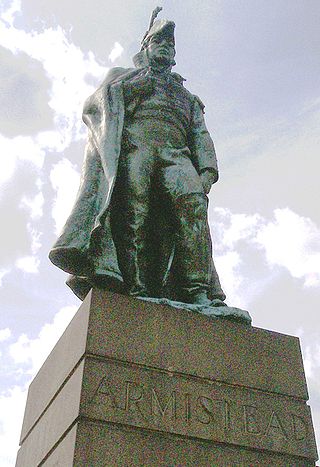
The Armistead Monument is a bronze statue of Col. George Armistead, by Edward Berge. It is located at Fort McHenry, Baltimore. It was dedicated on September 12, 1914.
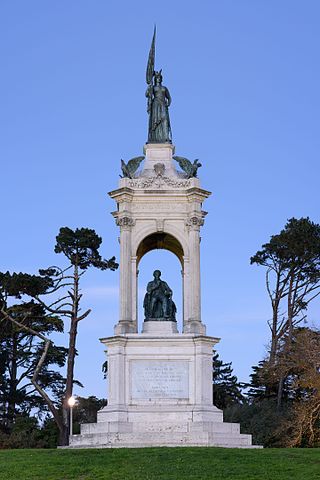
A memorial statue of Francis Scott Key stood in Golden Gate Park, San Francisco, in the U.S. state of California, from 1888 until 2020.

The Dawn's Early Light is a 1972 non-fiction book by Walter Lord about the War of 1812 Battle of Baltimore and the events leading up to it. Lord said he wrote the book because of the event's significance in American history. It is one of his 13 bestsellers.


















